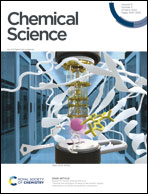A homogeneous high-DAR antibody–drug conjugate platform combining THIOMAB antibodies and XTEN polypeptides†
Abstract
The antibody–drug conjugate (ADC) is a well-validated modality for the cell-specific delivery of small molecules with impact expanding rapidly beyond their originally-intended purpose of treating cancer. However, antibody-mediated delivery (AMD) remains inefficient, limiting its applicability to targeting highly potent payloads to cells with high antigen expression. Maximizing the number of payloads delivered per antibody is one key way in which delivery efficiency can be improved, although this has been challenging to carry out; with few exceptions, increasing the drug-to-antibody ratio (DAR) above ∼4 typically destroys the biophysical properties and in vivo efficacy for ADCs. Herein, we describe the development of a novel bioconjugation platform combining cysteine-engineered (THIOMAB) antibodies and recombinant XTEN polypeptides for the unprecedented generation of homogeneous, stable “TXCs” with DAR of up to 18. Across three different bioactive payloads, we demonstrated improved AMD to tumors and Staphylococcus aureus bacteria for high-DAR TXCs relative to conventional low-DAR ADCs.

- This article is part of the themed collection: Most popular 2022 chemical biology articles


 Please wait while we load your content...
Please wait while we load your content...